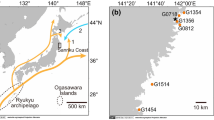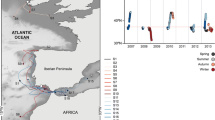Abstract
The ocean sunfish (Mola mola) is typically considered to feed on gelatinous zooplankton, but reports in the literature describe various benthic organisms being found in their stomachs. This might reflect ontogenetic dietary shift, as little was known about the foraging habit of this species. We examined their foraging habits using dietary analyses in combination with a behavioral study in Iwate, Japan (39°22′N, 141°58′E) from 2009 to 2010. Our stomach content analyses (n = 17, 31–250 cm total length) suggested that small sunfish (<50 cm) feed on benthic crustaceans, but large sunfish (>200 cm) feed on jellyfish. Larger sunfish showed higher values of both carbon and nitrogen stable isotope ratios. Deployment of accelerometers and animal-borne cameras on small sunfish in July (49–58 cm, n = 5) suggested their possibility of feeding, while they stayed near the seabed. This indicates that small sunfish might feed on benthic preys. Deployment of accelero-magnetometers on large sunfish in July (84–164 cm, n = 4) clarified that the large sunfish in July swam back and forth between the surface and deep water (>100 m). Temporary decelerations, which were considered to be associated with feeding of planktonic prey, were observed in deep water. Whereas deployment of accelero-magnetometers on large sunfish in November (105 cm, n = 3) showed several bursts, they swam within the mixed layer (0–100 m), which might be associated with chasing of rapid prey. These results suggest that ocean sunfish have heterogeneous diets depending on their body size and possibly season.








Similar content being viewed by others
References
Bass AL, Dewar H, Thys T, Streelman JT, Karl SA (2005) Evolutionary divergence among lineages of the ocean sunfish family, Molidae (Tetraodontiformes). Mar Biol 148:405–414
Carey FG, Scharold JV (1990) Movements of blue sharks (Prionace glauca) in depth and course. Mar Biol 106:329–342
Cartamil DP, Lowe CG (2004) Diel movement patterns of ocean sunfish Mola mola off southern California. Mar Ecol Prog Ser 266:245–253
Carvalho MC, Hayashizaki K, Ogawa H (2006) Trophic relations between animal and non-animal matter in sediments investigated using stable isotopes. Coast Mar Sci 30:233–237
Clemens WA, Wilby A (1961) Fishes of the Pacific coast of Canada, 2nd edn. Fisheries Research Board of Canada Bulletin, Otawa
Dewar H, Thys T, Teo SLH, Farwell C, O’Sullivan J, Tobayama T, Soichi M, Nakatsubo T, Kondo Y, Okada Y, Lindsay DJ, Hays GC, Walli A, Weng K, Streelman JT, Kari SA (2010) Satellite tracking the world’s largest jelly predator, the ocean sunfish, Mola mola, in the Western Pacific. J Exp Mar Biol Ecol 393:32–42
Eckert SA, Stewart BS (2001) Telemetry and satellite tracking of whale sharks, Rhincodon typus, in the Sea of Cortez, Mexico, and the North Pacific Ocean. Environ Biol Fish 60:299–308
Fleming NEC, Houghton JDR, Magill CL, Harrod C (2011) Preservation methods alter stable isotope values in gelatinous zooplankton: implications for interpreting trophic ecology. Mar Biol 158:2141–2146
France R (1995) Carbon-13 enrichment in benthic compared to planktonic algae: foodweb implications. Mar Ecol Prog Ser 124:307–312
Fraser-Brunner A (1951) The ocean sunfish (family Molidae). Br Mus (Nat Hist) Zool 1:87–121
Gregory WK (1933) Fish skulls: a study of the evolution of natural mechanisms. The American Philosophical Society, Philadelphia
Harrod C, Syväranta J, Kubicek L, Cappanera V, Houghton JDR (2013) Reply to Logan and Dodge: ‘stable isotopes challenge the perception of ocean sunfish Mola mola as obligate jellyfish predators’. J Fish Biol 82:10–16
Hart JL (1973) Pacific fishes of Canada. Fisheries Research Board of Canada Bulletin, Otawa
Hays GC, Farquhar MR, Luschi P, Teo SLH, Thys TM (2009) Vertical niche overlap by two ocean giants with similar diets: ocean sunfish and leatherback turtles. J Exp Mar Biol Ecol 370:134–143
Hoar WS (1953) Control and timing of fish migrations. Biol Rev 28:437–452
Holland KN, Brill RW, Chang RKC, Sibert JR, Fournier DA (1992) Physiological and behavioral thermoregulation in bigeye tuna (Thunnus obesus). Nature 358:410–412
Hooper SN, Paradis M, Ackman RG (1973) Distribution of trans-6-hexadecenoic acid, 7-methyl-7-hexadecenoic acid and common fatty acids in lipids of ocean sunfish Mola mola. Lipids 8:509–516
Houghton JDR, Liebsch N, Doyle TK, Gleiss AC, Lilley MKS, Wilson RP, Hays GC (2009) Harnessing the sun: testing a novel attaching method to record fine scale movements in ocean sunfish (Mola mola). Rev Method Technol Fish Biol Fish 9:229–242
Ichikawa T, Segawa K, Terazaki M (2006) Estimation of Cnidaria and Ctenophora biomass and vertical distribution using the video plankton recorder II (VPRII) in the meso- and epipelagic layers of the Oyashio and transition zone off eastern Japan. B Jpn Soc Fish Oceanogr 70:240–248
Kawase H, Nakazono A (1996) Two alternative female tactics in the polygynous mating system of the threadsail filefish Stephanolepis cirrhifer (Monacanthidae). Ichthyol Res 43:315–323
Kiljunen M, Grey J, Sinisalo T, Harrod C, Immonen H, Jones RI (2006) A revised model for lipid-normalising δ13C values from aquatic organisms, with implications for isotope mixing models. J Appl Ecol 43:1213–1222
Lowe CG, Wetherbee BM, Crow GL, Tester AL (1996) Ontogenetic dietary shifts and feeding behavior of the tiger shark, Galeocerdo cuvier, in Hawaiian waters. Environ Biol Fish 47:203–211
MacGinitie GE, MacGinitie N (1968) Natural history of marine animals, 2nd edn. McGraw-Hill Book Company, New York
Menzies RJ, Imbrie J, Heezen BC (1961) Further considerations regarding the antiquity of the abyssal fauna with evidence for a changing abyssal environment. Deep Sea Res 8:91–94
Nakamura I, Watanabe YY, Papastamatiou YP, Sato K, Meyer CG (2011) Yo-yo vertical movements suggest a foraging strategy for tiger sharks Galeocerdo cuvier. Mar Ecol Prog Ser 424:237–246
Norman JR, Fraser FC (1949) Field book of giant fishes. GP Putnam and Sons, New York
Parker PL (1964) The biogeochemistry of the stable isotopes of carbon in a marine bay. Geochim Cosmochim Acta 28:1155–1164
Percell JE, Arai MN (2001) Interactions of pelagic cnidarians and ctenophores with fish: a review. Hydrobiologia 451:27–44
Peterson BJ (1999) Stable isotopes as tracers of organic matter input and transfer in benthic food webs: a review. Acta Oecologica 20:479–487
Pope EC, Hays GC, Thys TM, Doyle TK, Sims DW, Queiroz N, Hobson VJ, Kubicek L, Houghton JDR (2010) The biology and ecology of the ocean sunfish Mola mola: a review of current knowledge and future research perspectives. Rev Fish Biol Fish 20:471–487
Potter IF, Howell WH (2011) Vertical movements and behavior of the ocean sunfish, Mola mola, in the northwest Atlantic. J Exp Mar Biol Ecol 396:138–146
Potter IF, Galuardi B, Howell WH (2011) Horizontal movement of ocean sunfish, Mola mola, in the Northwest Atlantic. Mar Biol 158:531–540
R Development Core Team (2013) R: a language and environment for statistical computing. R Foundation for Statistical Comput-ing, Vienna. http://www.R-project.org/. Accessed 23 July 2013
Roach J (2003) World’s heaviest bony fish discovered? National Geographic. http://news.nationalgeographic.com/news/2003/05/0513_030513_sunfish.html. Accessed 23 July 2013
Sagara K, Ozawa T (2002) Landing statistics of molids in four prefectures of Japan. Mem Fac Fish Kagoshima University 51:27–33
Sakamoto KQ, Sato K, Ishizuka M, Watanuki Y, Takahashi A, Daunt F, Wanless S (2009) Can ethograms be automatically generated using body acceleration data from free-ranging birds? PLoS One 4:e5379
Sato K, Mitani Y, Cameron MF, Sniff DB, Naito Y (2003) Factors affecting stroking patterns and body angle in diving Weddell seals under natural conditions. J Exp Biol 206:1461–1470
Sato K, Watanuki Y, Takahashi A, Miller PJO, Tanaka H, Kawabe R, Ponganis PJ, Handrich Y, Akamatsu T, Watanabe Y, Mitani Y, Costa DP, Bost CA, Aoki K, Amano M, Trathan P, Shapiro A, Naito Y (2007) Stroke frequency, but not swimming speed, is related to body size in free-ranging seabirds, pinnipeds and cetaceans. Proc R Soc Lond B 274:471–477
Sedberry GR, Loefer JK (2001) Satellite telemetry tracking of swordfish, Xiphias gladius, off the eastern United Stats. Mar Biol 139:355–360
Shiomi K, Narazaki T, Sato K, Shimatani K, Arai N, Ponganis PJ, Miyazaki N (2010) Data processing artifacts in three-dimensional dive path reconstruction from geomagnetic and acceleration data. Aquat Biol 8:299–304
Sims DW, Queiroz N, Humphries NE, Lima FP, Hays GC (2009a) Long-term GPS tracking of ocean sunfish Mola mola offers a new direction in fish monitoring. PLoS One 4:e7351
Sims DW, Queiroz N, Doyle TK, Houghton JDR, Hays GC (2009b) Satellite tracking of the World’s largest body fish, the ocean sunfish (Mola mola L.) in the North East Atlantic. J Exp Mar Biol Ecol 370:127–133
Syväranta J, Harrod C, Kubicek L, Cappanera V, Houghton JDR (2012) Stable isotopes challenge the perception of ocean sunfish Mola mola as obligate jellyfish predators. J Fish Biol 80:225–231
Vereshchaka AL, Vinogradov GM (1999) Visual observations of the vertical distribution of plankton throughout the water column above Broken Spur vent field, Mid-Atlantic Ridge. Deep sea Res Pt I 46:1615–1632
Vinogradov GM (2005) Vertical distribution of macroplankton at the Charlie-Gibbs Fracture Zone (North Atlantic), as observed from the manned submersible ‘‘Mir-1”. Mar Biol 146:325–331
Wada Y, Kashiwagi N (1990) Selecting statistical models with information statistics. J Dairy Sci 73:3575–3582
Watanabe Y, Sato K (2008) Functional dorsoventral symmetry in relation to lift-based swimming in the ocean sunfish Mola mola. PLoS One 3:e3446
Watanabe Y, Baranov EA, Sato K, Naito Y, Miyazaki N (2006) Body density affects stroke patterns in Baikal seals. J Exp Biol 209:3269–3280
Wetherbee BM, Crow GL, Lowe CG (1996) Biology of the Galapagos shark, Carcharhinus galapagensis, in Hawai’i. Environ Biol Fish 45:299–310
Acknowledgments
This study was supported by the Bio-Logging Science of the University of Tokyo (UTBLS), by the Grants-in-Aid for Scientific Research from the Japan Society for the Promotion of Science (A19255001 and 12J07184), by the Research Fund for Fisheries Promotion by Otsuchi Town, and by the Cooperative Program of Atmosphere and Ocean Research Institute, The University of Tokyo. The procedures were approved by the ethics committee at the University of Tokyo (Institutional Animal Case and Use Committee Protocol #P09-2, P10-1). We thank Y. Watanabe and E. Sawai for their assisting and advising for this study, T. Miyajima and C. Harrod for his teaching stable isotope technique, and C. G. Meyer, A. Gleiss and Y. Akiyama for helpful comments on the draft and correction of English documents. We greatly thank fishermen in Otsuchi Bay Fisheries Association and the captain and crews of the R/V ‘Yayoi’ from the International Coastal Research Center for assistance with the fieldwork.
Author information
Authors and Affiliations
Corresponding author
Additional information
Communicated by J. D. R. Houghton.
Rights and permissions
About this article
Cite this article
Nakamura, I., Sato, K. Ontogenetic shift in foraging habit of ocean sunfish Mola mola from dietary and behavioral studies. Mar Biol 161, 1263–1273 (2014). https://doi.org/10.1007/s00227-014-2416-8
Received:
Accepted:
Published:
Issue Date:
DOI: https://doi.org/10.1007/s00227-014-2416-8




